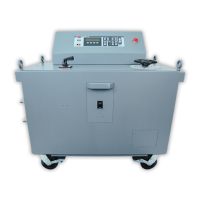SECTION V
1. TEST PROCEDURES FOR TESTING OF MOTOR OVERLOAD RELAYS
Always refer to the manufacturer's literature applicable to the particular overload relay
before testing. The test operator should be familiar with the operating characteristics
of
the relay, the tolerances applicable to the operating characteristics and any means
of
adjusting the relay.
The test usually performed on these devices is to verify the time delay characteristics
of
. the relay when subjected to an overload condition. One test point is usually suggested
to
establish whether the relay
is
operating correctly and within the band
of
the time-
current curve
for
the relay. The suggested test current is three times (3x) the normal
current rating
of
thermal overload relays
or
three times (3x) the pick-up current (setting)
of
magnetic overload relays.
It
is,
of
course, easiest to make the connections and perform the tests on the relays if
they are removed from the starter. However, it
is
not necessary to remove the relay
as
long as the power circuit is de-energized and the test leads can be connected to the
device. The high current
leads from the test set to the relay under test should be kept
as short as
possible and should be twisted to minimize losses caused by inductive
reactance.
Run the test and note the time required for the
overload relay to trip.
If
the tripping time
exceeds the manufacturer's recommended
value, or
if
the relay does not trip at all, the
relay may not be protecting the motor properly.
If
th.e
relay operates too quickly, it may
result in unnecessary nuisance trips.
It should be remembered that these devices
operate over a wide band and precise
results should not be sought. A tolerance
of
.±
15% is usually acceptable for electromechanical devices.
If
a thermal overload relay is not operating properly, tripping too soon
or
too late,
remove the heater element. Note its type, rating, etc., and compare with
manufacturer's data
for
operating characteristics
of
the motor.
If
correct
for
the
application, substitute a new heater
of
the same rating and retest.
If
either under- or
over-sized heater
elements are being used, replace with the proper size heater and
retest.
If
a magnetic overload relay is not operating properly, refer to the relay manufacturer's
literature for instructions on making adjustments
of
the time delay.
If
the relay is
operating
improperly, it also may be desirable to verify the pickup point (minimum
operating point)
of
the relay. To perform this test, it is necessary to disengage the time
delay feature
of
the overload relay. Refer to the manufacturer's literature for detailed
instructions.
19

